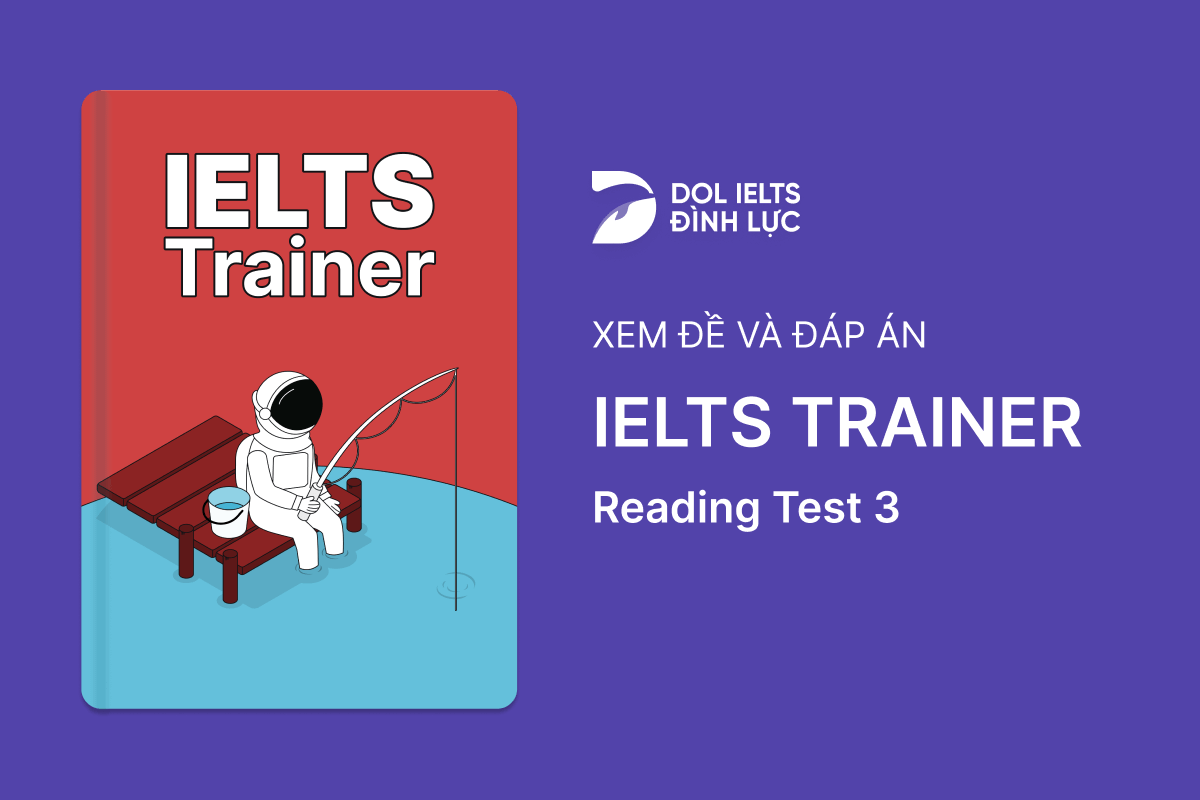IELTS Trainer - Reading Test 3 With Practice Test, Answers And Explanation
Luyện tập đề IELTS Online Test IELTS Trainer - Reading Test 3 được lấy từ cuốn sách IELTS Trainer với trải nghiệm thi IELTS trên máy và giải thích đáp án chi tiết bằng Linearthinking, kèm answer key và list từ vựng IELTS cần học trong bài đọc.
Passage
📖 Bài đọc passage 1
❓ Câu hỏi passage 1

🔥 Đáp án & giải thích 1
Giải thích chi tiết
Áp dụng DOL’s Linearthinking 
Hiểu câu hỏi: Vì chỗ trống đứng ngay sau cụm “consist of….” => Cần điền một Noun vào chỗ trống So sánh thông tin trong câu hỏi và bài đọc:
1 A work of art will make the vault visible for miles with reflective sheets of steel and mirrors which form an installation acting as a beacon
2 It reflects polar light .
Câu 1 + 2 => The installation made by steel and mirrors reflects polar light.
Passage
📖 Bài đọc passage 2
❓ Câu hỏi passage 2
🔥 Đáp án & giải thích 2
Giải thích chi tiết
Áp dụng DOL’s Linearthinking 
Khi nhìn vào câu hỏi, trước hết cần phân tích cấu trúc câu hỏi để biết cần điền loại từ nào vào chỗ trống. Vì chỗ trống đứng ngay sau tính từ sở hữu “their" => cần điền một Noun vào đây. (1) bookshop contains many more recipes than one person could hope to take in a lifetime => Bookshops have more recipes than necessary.
(2) Although the recipes in one book are often similar to those in another , their presentation varies wildly
=> The recipes are similar but the presentations are different.
=> (1) + (2): Bookshops contain more recipes than necessary and the presentations of the recipes are different.
Câu hỏi: ... and it is their __________ which makes them differ from each other. = the presentations of the recipes are different.
=> Đáp án: presentations 
Passage
📖 Bài đọc passage 3
❓ Câu hỏi passage 3
🔥 Đáp án & giải thích 3
Giải thích chi tiết
Skimming/scanning 
Nếu skim/scan để locate thông tin cho câu này, thí sinh sẽ rất dễ chọn đáp án “NOT GIVEN" vì thấy trong bài chẳng hề đề cập gì tới những keyword như “ignore" hay “impact” trong câu hỏi
=> Phải thực sự hiểu nghĩa câu hỏi và bài đọc thì mới so sánh được chính xác thông tin.
Nếu skim/scan để locate thông tin cho câu này, thí sinh sẽ rất dễ chọn đáp án “NOT GIVEN" vì thấy trong bài chẳng hề đề cập gì tới những keyword như “ignore" hay “impact” trong câu hỏi
=> Phải thực sự hiểu nghĩa câu hỏi và bài đọc thì mới so sánh được chính xác thông tin.
Áp dụng DOL’s Linearthinking 
1. Many people who spend a lot of time playing video games insist that they helped them in areas.
2. Yet this way of thinking about video games can be found almost nowhere within the mainstream media
=> “This way of thinking" chính là đề cập lại về lợi ích của video games trong câu 1 (helped them in areas)
=> 2 câu có thể tóm lại là: Video games have many benefits but these benefits cannot be found in mainstream media
=> Mainstream media do not pay attention to the benefits of video games.
Câu hỏi: Much media comment ignores the impact that video games can have on many people’s lives.
1. Many people who spend a lot of time playing video games insist that they helped them in areas.
2. Yet this way of thinking about video games can be found almost nowhere within the mainstream media
=> “This way of thinking" chính là đề cập lại về lợi ích của video games trong câu 1 (helped them in areas)
=> 2 câu có thể tóm lại là: Video games have many benefits but these benefits cannot be found in mainstream media
=> Mainstream media do not pay attention to the benefits of video games.
Câu hỏi: Much media comment ignores the impact that video games can have on many people’s lives.
-> Much media comment không quan tâm đến ảnh hưởng của video games lên đời sống con người
-> Thông tin câu hỏi trùng khớp với bài đọc
=> Đáp án: TRUE 


